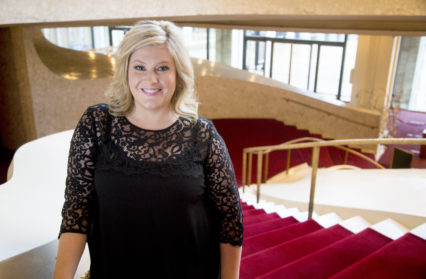Cath Barton attended a performance by mezzo-soprano Karen Cargill and pianist Simon Lepper and found it demonstrated significant versatility and musical intelligence.
Having a vibrant music college in Cardiff means that we are lucky enough to be able to follow the development of the professionals of the future. It also means that we sometimes get opportunities to hear top professionals who put on public recitals while they are visiting the college to teach.
The Scottish mezzo-soprano Karen Cargill has made her name as a Wagnerian singer, but showed in this song recital with her regular recital partner Simon Lepper that she should not be identified only as such. She is clearly a singer of great musical intelligence, able to convey all the subtleties of a song in an intimate setting, and it was a delight to hear her singing the familiar and some less well-known French mélodies which made up the bulk of this programme.
The lovely A Chloris by Venezuelan-born Reynaldo Hahn was a perfect opening song, and one in which Cargill made an immediate connection with her audience, caressing the words with clear understanding and commitment to their meaning. She maintained the atmosphere at the end of the song and so could move seamlessly into the second of her five Hahn songs, Le Rossignol des Lilas. This ability to hold an audience, especially at the end of a song when the piano line often plays out the final bars, is a fine quality in a singer.
The Hahn songs were all about love, an arena in which emotions can too easily become undifferentiated. Not so here. Cargill and Lepper worked as an obviously well-practised team, moving together through a wide range of dynamics and moods, until the way they leant together on the word ‘plainte’ (lament) in the last line of Les Fontaines was a satisfying conclusion to this set.
The period when Hahn was working – the end of the nineteenth century and beginning of the twentieth – was the time of the flowering of the French mélodie, the equivalent of German Lieder and English art song. Hahn was firmly in the Romantic tradition but Debussy’s work is more specifically impressionist, fluid and atmospheric like the painting school born in Paris during the same period.
Debussy’s song triptych Trois Chansons de Bilitis was, as interpreted by Cargill and Lepper, a revelation to me. These songs, almost recitative, were revealed as intense short dramas. In them Cargill demonstrated her ability to colour the words and also her considerable acting skills, particularly after she had stopped singing and the piano continued to tell each micro story. I was entranced by these deceptively coy other-worldly tales, as if I was hearing them here for the first time.
Interpretation is all in the world of song. Singing the right notes at the right time is only the start. The line of music is made up of nuance, the way in which a singer lingers on a note or employs mezza-voce at a particular moment, and – crucially – is at one with her pianist. I was interested to read in the programme that Simon Lepper is Professor of Collaborative Music at the Royal College of Music. For true collaborators is what these two performers showed themselves to be, as much entwined in their music-making as the lovers are with one another in Debussy’s La Chevelure.
Lyricism is at the heart of all this repertoire, but it is interesting to hear the differences between the work of French composers working around the same time. In four songs from Chausson’s Opus 2 dating from between 1879 and 1883, his work can be heard moving from the Romanticism of Hahn towards the impressionism of Debussy. In Sérénade italienne the rippling piano lines convey the rolling waves which – say the words of Paul Bourget’s poem – alone with the night and sky understand the lovers. Leconte de Lisle, who was (I would suggest) a greater poet, inspired song-writing of a more complex and higher calibre in Le Colibri, a transcendent setting of his poem comparing the life and death of a hummingbird to that of a lover’s passion. The flight and hovering is palpable in the music. At the moment when the bird dies, sated with nectar, the singer moves alone into silence. This is a heart-stopping moment, beautifully achieved in this performance.

Sadly, Duparc destroyed many of his compositions. We are left, however, with a number of his exquisite mélodies. It is not always the case (be it in French, German or English) that the better poet has inspired the better song, but the words of Baudelaire’s L’invitation au Voyage certainly inspired Duparc to produce remarkable vocal writing. Cargill sang the repeated words ‘Luxe, calme et volupté’ in that song in such a way as to express layers of meaning in them.
The highlight of the recital for me though was Duparc’s L’éxtase, which was ecstasy embodied in sound to such an extent that the entire audience seemed to hold its breath throughout the song.
In her final Duparc song, Phydilé, Karen Cargill began to open out her voice in a way that prepared the way for her exploration of the deeper and richer tones of her voice in Wagner’s Wesendonck Lieder. In these five songs from 1857-8, there was great intensity in the word-painting by composer and singer alike. Wagner himself declared two of these songs, Im Treibhaus and Träume, to be studies for his opera Tristan and Isolde, a work in which Cargill has also sung.
If ever there was a performance that showed that a singer can be as expressive in recital as on the operatic stage this was it. And full respect and credit to Simon Lepper for his playing, by turns delicate and robust, as the music required. Here was all the beauty of detail shown by a singer and a pianist at ease with one another, their material and their audience.
The Eriskay Love Lilt, charmingly dedicated to certain friends of the singer in the audience, was a delightful encore.
Karen Cargill, mezzo-soprano
Simon Lepper, piano
Dora Stoutzker Hall, Royal Welsh College of Music and Drama, Cardiff
14th March 2018
Header photo of Karen Cargill by K K Dundas
Cath Barton’s novella The Plankton Collector is due to be published in September 2018 by New Welsh Review under their Rarebyte imprint. She has been awarded a place on the 2018 Literature Wales Mentoring Scheme, to work on a collection of short stories inspired by the work of the sixteenth century Dutch artist Hieronymus Bosch.
You might also like…
Cath Barton visits the Royal Welsh College of Music and Drama to witness a recital by Llŷr Williams, the second concert in his Pictures in Music Series.



 Enjoyed this article? Support our writers directly by buying them a coffee and clicking this link.
Enjoyed this article? Support our writers directly by buying them a coffee and clicking this link.







